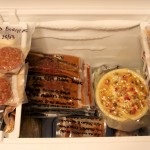This is a guest post written by the very talented (and super practical) Hennie Camley.

FROM KITCHEN-NEWB TO KITCHEN-DON’T-SEEM-SO-NEWB
When Sunshine first asked me to write a guest post, I laughed – nay, I full on scoffed! Despite my recent efforts in the kitchen, Julia Child, I am not. Who could possibly be interested in anything I would have to say? But then I remembered; when I was first approached to teach dance classes, I scoffed then as well – nay, I full on snorted! I thought then, who could possibly be interested in anything I would have to say? Surprisingly, it turned out to be a number of people. As I gained confidence in front of the dance class I realized that having been a novice so recently, I had unique insight into what it was that helped me progress so quickly from toe-trampler to dance teacher. I had not become so good that the steps were second nature. I still had to think about what I was doing and was able to articulate the thought process behind each of the steps that I taught.
I’ve never been known as a homebody, I had a difficult time envisioning myself as a wife or a mother. Most of my bachelorette nights were spent grabbing convenient nourishment between dance classes, and on some nights a box of crackers and a can of lychee were my best friends. Being young and active, I could afford to eat all sorts of glorious fast food with nary a second thought. I was incredibly free and answered to only myself.

photo credit to H Camley
As the story often goes, my life took a very a sudden and unexpected turn a few years ago when I met the proverbial geeky boy. Several months later, we were moving in together and combining the contents of our refrigerators – which really only amounted to a modest collection of condiments. In my pantry, I moved over two cans of mushroom soup, a box of instant cake mix, and a can of Spam (I had just eaten the lychee) to make room for his box of Kraft Dinner and half a bag of egg noodles. We had both been single for a very, very long time!

credit to H Camley
LESSON: THE FIRST
During the first few months of cohabitation, dinners were mainly take-out, although once a week or so one of us would make the foray into our tiny condo-sized kitchen to make a mess. Each time I ventured into the kitchen I was armed with an elaborate recipe, hoping to wow my husband-to-be.
Herein lies lesson number one: more elaborate recipes don’t make better meals.
Elaborate recipes can turn cooking into a chore, especially on weeknights when you’re already exhausted from nine-to-fiving then commuting to six and they usually require an unnecessarily long list of ingredients. My best advice to any newbie kitchen explorer: simplify.
Ingredient lists should be comprised of pantry items that are common to a number of recipes. It doesn’t make sense to buy ingredients you may only use once. Build an arsenal of simple recipes with basic ingredients and save the elaborate recipes for weekends when you have more time.

credit to H Camley
One of my favorite weeknight meals now is homemade Mac n’ Cheese: cook macaroni, shred cheese, add milk and bake. Simplicity can be delicious!
IDENTIFY THE FAT. FIRE AT WILL.
The early reincarnation of our budget allotted $700/month for groceries and about $200/month eating out. We were determined to start cooking at home more and we thought that this one minor adjustment to our lifestyles would pay our mortgage for us. This was not the case. We quickly learned that eating $900/month didn’t allow us to squirrel any money away for lovely things like vacations or sexy new shoes (the latter unbeknownst to my husband of course).
We stopped eating out. We were shopping at Superstore instead of SaveOn. We even armed ourselves with a shiny Costco card. Still, we were barely making a dent in our grocery bills. Even though we were eating at home more often, we were still over spending. Our kitchen habits were horribly inefficient. We were wasting a great deal of food and essentially throwing out our hard earned cash dollars every Thursday. Buying bulk cheese on sale is a wondrous thing. Throwing out ¾ of a block of moldy cheese-like substance is grounds for termination.
THE CHAIN MEAL
I soon realized that you can’t approach each meal individually. A meal plan that addresses only “what are we having tonight?” is wasteful of time, effort and resources. Even whilst diligently stopping at the grocery store every night after work, we were still on track to becoming those parents who live out their retirement in their first-born’s basement.
A meal plan needs to encompass more than just one meal. Tonight’s dinner should be prepared with tomorrow’s meals in mind. Any ingredients you don’t use up tonight should be incorporated into tomorrow night’s dinner – instead of being forgotten in your fridge or pantry till small colonies are amassing.
Feeding a family of even just two requires a contentious thought process. Grocery shopping only once every other week and buying in bulk is a good starting point. It forces you to plan your meals and to get creative with how you manage your inventory.
Let’s say you have a recipe that calls for chicken stock. Why buy a can when you can buy a carton for less per ml? On that note, why buy a single carton when you can buy a case for less per carton?
What does one do with all that chicken stock? Make rice! Having leftover chicken stock from Sunday dictates that our Monday meal will be served with rice. Instead of using water to cook the rice, I substitute chicken stock, adding half a tablespoon of olive oil and one tablespoon of light soya sauce. If I’m feeling fancy, I’ll throw in some golden raisins and almond slivers for a Mediterranean flare. I always make at least two cups of rice (which turns into four cups cooked) leaving us enough to pack our Tuesday lunches and make fried rice for dinner. I can’t stress enough how useful an ability to make fried rice is. It is such a versatile dish that works with almost any left overs. You can put anything it!
Here we’ve essentially strung three meals together (four if you count lunch). The longer the chain, the better! Planning dinner shouldn’t only be about what you want to eat, but rather, what can you make out of what you have that is equally delicious?
USE YOUR GOOGLE-FU
I have a butter and chive salmon recipe that is prepped and served in under 20 minutes. This makes it a household favorite. The grocery stores in my area only sell chives in prepackaged amounts and I always have a ton left over. So I dug deep, reaching for my inner Google kung-fu, and scoured the web for new, simple recipes involving chives.
I found a cheddar and chive buttermilk biscuit recipe with great reviews so I went out to pick up the missing ingredients. The store only sold buttermilk in one litre cartons and the recipe only called for a cup but one of the reviewers mentioned that the biscuits freeze nicely so I doubled the recipe. I froze all the leftover biscuits on a cookie tray individually overnight, then packaged them into two-person portions to be pulled out and thawed whenever our meal lacked a carb.
I repeated this process with the remaining half litre of buttermilk on regular plain biscuits and froze them unbaked. Whenever we want biscuits now, we just pop three or four directly into the oven for 20 minutes and fresh baked goodness is ours for the taking! We’re never stuck eating stale carbs for a week.
AN OBSESSION WAS BORN: FREEZER COOKING

credit to H Camley
Armed with the holy trinity of the modern housewife (a Costco membership, a deep freeze and a vacuum sealer), I’ve learned that premaking meals in bulk is a great time saver and a great way to save money.
My marathon cooking sessions have lasted anywhere from three to nine hours. It takes time and planning but more importantly it lets me maximize that time I spend in the kitchen. My math-mojo isn’t so great that I can say how many kilojoules of energy I save with freezer cooking, but what’s for certain is that the inconvenience of cooking on the weeknights has been displaced to a time of my choosing. I’ve enlisted the help of my sister-in-law and our time spent cooking together has become precious bonding time that we may not have been afforded otherwise. We’re on track to having her freezer filled with at least 60 meals before August, when her second child is due to be born.
Freezer cooking is something to be learned and practiced. No one is great at it from the get go, and had I known that, I may have started this sooner! Mistakes will be made, some food will be wasted, but it’s all part of the learning process.
Just recently, I changed the molecular structure of ham. The meat was inedible – sacrilege wasting such good pig! My sister-in-law’s husband, who has been married for many, many moons, spat out his first bite and fed the rest to the dog. My husband, being a newly-wed, dutifully choked his down and thanked me when I packed up the leftovers and made him take it for lunch.
I tweaked the recipe and tried again. Let’s just say I’ll be feeding the rest of this batch to my husband while I can still give him the newlywed eye-bat and get my way. Lesson learned: do not under ANY circumstances use fresh pineapple in freezer meals!
There’s a wealth of information on the internet about Once A Month Meal Plans. I haven’t quite taken it to this extreme yet. I’m still muddling my way through, constantly researching and trying new things. The problem with these websites is that they are blogged by what I can only assume are Supermoms who wear capes instead of aprons. The things they do are mind boggling! But they’ve become so good at their craft that sometimes a newbie like myself has a hard time following.
Be patient. Examine recipes. Read the comments!
Start slow! One of the easiest methods to start off with is the double up program. When you make a meal – double it. It takes an extra 1.865 minutes to construct a second lasagna to be packaged up and frozen for another day (and yes, that number was completely made up). This method allows you to use tried and true recipes that you can confidently make with relative ease. Start with what you know.
I’m now proudly sporting a monthly budget of $450 for groceries. We almost never eat out anymore, and I can go weeks without grocery shopping, free to spend my extra time in the evenings pursuing the multitude of other interests I have. Each week, it only gets easier. What more can a girl ask for?
Anything she wants, with the money she’s saved!






















